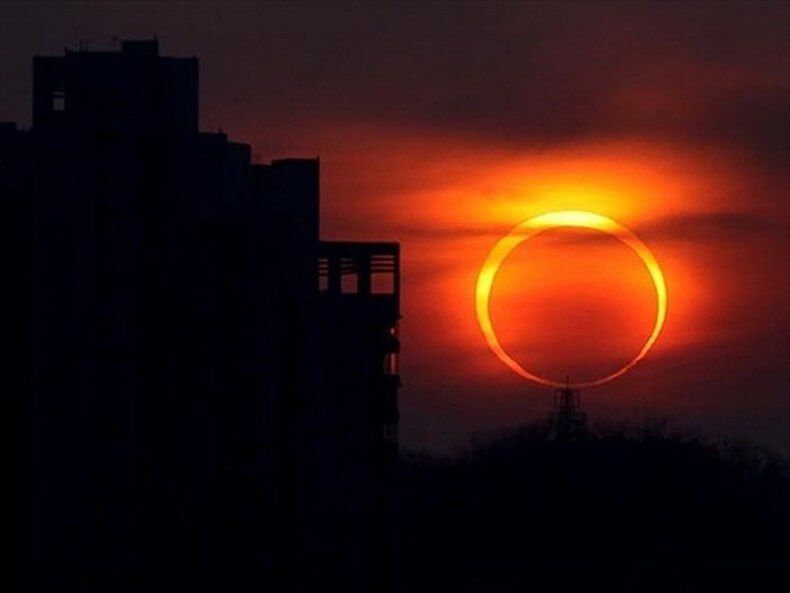It looks like you're using an Ad Blocker.
Please white-list or disable AboveTopSecret.com in your ad-blocking tool.
Thank you.
Some features of ATS will be disabled while you continue to use an ad-blocker.
share:
originally posted by: peacefulpete
I have yet to go through the whole thread, but to me, the most convincing thing is that on Earth, the moon appears the same size as the sun, for our eclipses to happen every once in a while.
Since the moon is completely smaller, it's an optical illusion that would seem too perfect to be natural.
The moon does not always appear to be the same size of the Sun because the orbital distance between the Earth and Moon can vary (as well as the distance between the earth and Sun). These varying distances can make the apparent size
(the size the moon appears from Earth) of the moon vary by 14% and the apparent size of the Sun vary by 3%.
This can result in the Moon sometimes looking smaller or larger than the Sun, as was the case during this eclipse in 2017 when the Moon was smaller than the Sun (called an "annular", which means "ring-shaped", eclipse):

and this one that happened in 2012:

Also, the fact that the moon is 1/4th the size of Earth is also pretty crazy, all by itself. Its size makes it seem like a small planet dancing with our bigger planet (Earth).
IIRC it's the biggest moon-to-planet ratio that we've ever seen (someone correct me if I'm wrong). But it's just another anomaly that seems too extreme to be natural.
Pluto is no longer considered a major planet, but its largest moon Charon is more than half the size of Pluto.
It seems maybe that the inner planets were less likely to form moons alongside the planet as the planet was forming -- i.e., have moon form from dust coming together around the planet as the planet itself is forming from a dust and gas ball coming together. This formation method, called "accretion", is thought to be the traditional way most of the moons around the giant outer planets formed.
However, only two of the four inner planets have moons at all (Mercury and Venus have none), so other unique methods of moon formation might have happened for Earth and Mars. The Moons of Mars are thought to have been captured asteroids from the asteroid belt (although accretion is another possible way they formed), and Earth's Moon is thought to have formed from an impact event, causing Earth to have an abnormally large moon
Heck if you were an alien, and found Earth with a moon that's 1/4th its size... I'd probably consider both objects as living planets, circling each other...
That might be true for Pluto and Charon. While Pluto tugs at Charon, Charon also tugs at Pluto, causing the barycenter of each of their orbits (the point around each body orbits) to be a point in space. That point is closer to Pluto than it is to Charon, but both Pluto and Charon orbit around that point, looking like they circle each other.
The Moon tugs on the Earth as well as it orbits, but the barycenter between the Earth-Moon system is a point that is still inside the Earth. So the Moon still orbits around the Earth itself, because that barycenter is in the Earth itself. Granted, Earth may appear to wobble around that barycenter as the Moon tugs on it, but it would not look as if the earth and Moon circle each other.
edit on 1/21/2019 by Soylent Green Is People because: (no reason given)
a reply to: Soylent Green Is People
Cool post, and at the end of your post, I didn't quite mean that the Earth is circling the moon, because it's not... The moon is obviously circling Earth.
But my point was that an alien species would see our planet full of life, with a 25% size moon circling us, and they'd probably just assume the moon was also a living, smaller "planet," given its relatively large size, and its same location in space (as Earth), etc.
Re: the relative size of moon and sun from Earth: Ok so they don't perfectly appear exactly the same size... but when we see an eclipse, it's near perfect enough to resemble a huge, intentional, artificial, living art piece.
Cool post, and at the end of your post, I didn't quite mean that the Earth is circling the moon, because it's not... The moon is obviously circling Earth.
But my point was that an alien species would see our planet full of life, with a 25% size moon circling us, and they'd probably just assume the moon was also a living, smaller "planet," given its relatively large size, and its same location in space (as Earth), etc.
Re: the relative size of moon and sun from Earth: Ok so they don't perfectly appear exactly the same size... but when we see an eclipse, it's near perfect enough to resemble a huge, intentional, artificial, living art piece.
edit on 21-1-2019 by peacefulpete because: (no reason
given)
new topics
-
Why Such An Uproar Over Non-US Citizens With H1-B Work Visas.
Social Issues and Civil Unrest: 1 hours ago -
Christmas Car Near Detroit…
Automotive Discussion: 3 hours ago -
Assetto Corsa EVO - a New Chapter in Simracing starts January 16th
Video Games: 6 hours ago -
The Phenomenon documentary by James Fox
Aliens and UFOs: 9 hours ago -
New UK Petition - Close the borders! Suspend ALL immigration for 5 years!
Regional Politics: 10 hours ago
